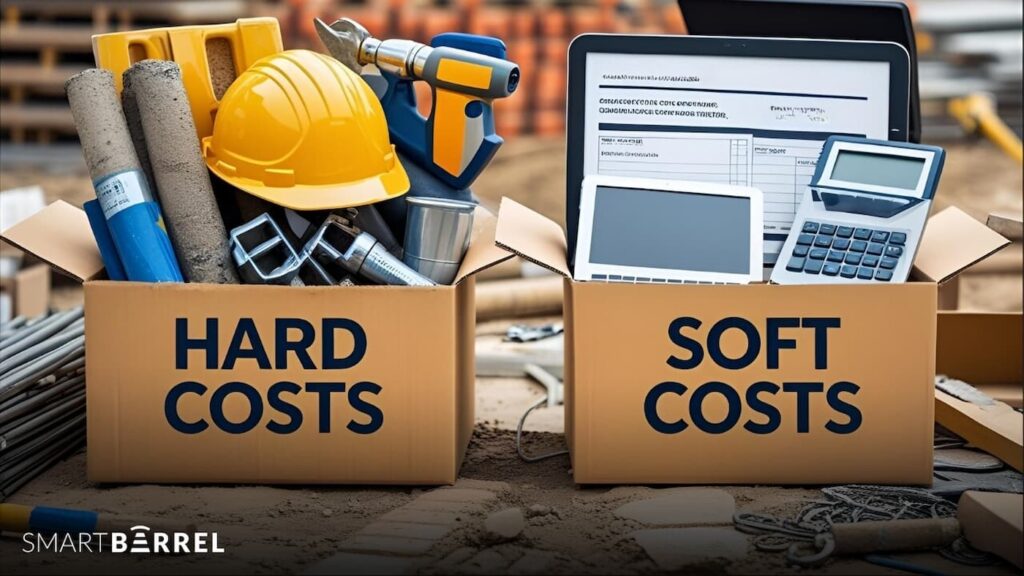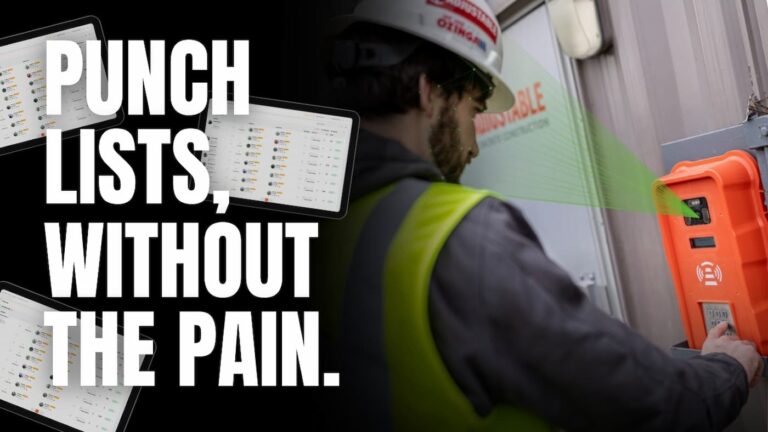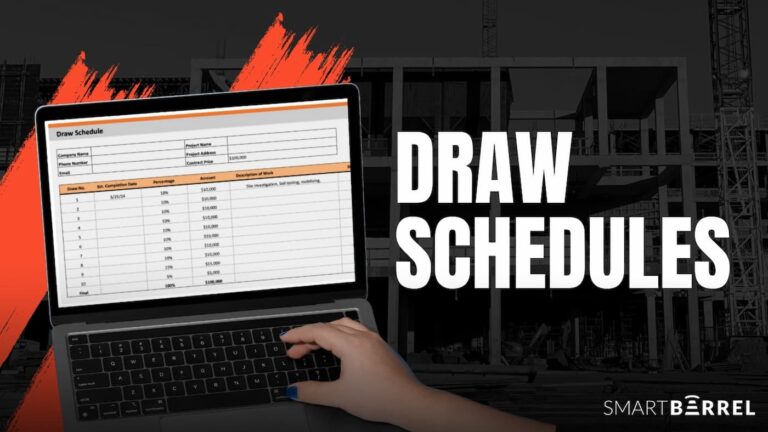You can win the lowest bid and still lose money if you miss hidden costs. Miss the soft costs? Underestimate the hard costs? Your profit’s gone before the first punch list walk.
Most contractors get this wrong because they focus so much on the obvious hard costs that they miss the hidden soft costs that eat away at profit.
Before you send your next bid, know exactly what’s hiding behind “hard costs vs soft costs.” Here’s the line item breakdown every contractor should double-check.
What Are Hard Costs in Construction?
Hard costs, or “brick and mortar” costs, are directly related to the physical construction. These are the costs that are essential to the construction of the project. Oftentimes, they are the largest portion of your budget, roughly 70-85% of it. Since costs are tangible, they’re generally easier to estimate.
To keep estimating easy and cover the variables of each project, hard costs can be broken down into three categories:
Materials
All raw materials you plan to use, big and small, must be accounted for. This is all your lumber, drywall, insulation, steel, roofing, etc. And remember your caulking, nails, screws, drill bits, saw blades, etc.
This also includes materials used for the interior scope of work. This will vary depending on your project, but commonly consists of doors, windows, and paint.
Labor
All wages and benefits paid to all employees working on the project, both skilled and general labor. This also includes all wages and benefits paid to subcontractors who perform any work, especially special system installations like HVAC, alarms, and sprinkler systems.
Equipment & Site Prep
Purchasing and renting construction machinery and tools. These are your big ticket items like bulldozers, cranes, and cherry pickers. Small ticket items can add up as well, such as scaffolding and power tools.
Preparing your site is a key component of your company’s success. If your construction site needs temporary water, temporary power, or excavation, those are hard costs.
If your construction site needs walkways, safety areas, or any access road prep at all, those are also hard costs.
Regardless of the company or project, hard costs are always incurred during the length of construction.
What Are Soft Costs In Construction?
While soft costs are often tracked in detail by general contractors or owners, subcontractors still feel their impact, especially when managing their insurance, project admin, or indirect jobsite expenses. Whether you label them as overhead, general conditions, or indirect costs, soft costs still affect your bottom line.
Soft costs are indirect expenses needed to complete the project, but aren’t directly tied to your hard costs. For specialty contractors, these costs often include project management time, permit fees, trailer rentals, liability insurance, and more. They may not always show up as line items on bids, but they still need to be tracked internally, especially on T&M jobs or when backing up reports for a GC. Most companies address soft costs as overhead and administrative fees. While soft costs are typically lower than hard costs, soft costs still cover the entire project, from concept to completion.
Soft costs can be broken down into four manageable categories:
Planning & Design Costs
Depending on the scope of work, these soft costs can vary greatly. They include architectural fees for designs and blueprints, engineering fees, and sometimes zoning fees to ensure regulatory compliance. They may include building permits and inspection fees for various stages of construction. Lastly, there’s always at least some interior design fees for interior layout and finishes.
Financing Costs
Most, if not all, commercial construction gets started with finances dispersed from loans. You should anticipate loan origination fees charged by lenders to process and establish the construction loan. Be mindful of the interest that’s accrued during the construction period. It’s also smart to track any bank fees associated with any financial transactions.
Insurance & Taxes
Every commercial project requires builder’s risk insurance, general liability insurance, and workers’ comp. It’s also good to have professional liability insurance to protect against claims of negligence or errors from your subcontractors.
Always stay on top of your taxes. Real estate and property taxes. State and local taxes. Taxes on permits and licences. Depending on the scope of work, there may be other taxes as well.
Project Management
If your project hires a project manager or team to oversee the entire project, or any special consultants for health and safety, they each have their own fees. These may include administrative expenses for temporary offices, the related rental and storage costs, and salaries for admin staff not directly involved in physical labor.
That speaks to construction soft costs overall. Soft costs are lower by default—hard costs make up most of your budget—but they are oftentimes difficult to predict.
Get Control of Your Time Tracking
Key Differences Between Hard Costs and Soft Costs
Understanding the key differences between hard costs and soft costs is crucial to effective budgeting and project planning. Hard costs are tangible and direct. Soft costs are intangible and indirect. Now that you have real examples of hard costs and soft costs, let’s look at the key differences that impact project planning.
Visibility
Hard costs are easily visible and measurable. You can see what you’re paying for in the actual structure.
Soft costs are often “behind the scenes”. They don’t directly result in a physical part of the project.
Timing
Hard costs are primarily incurred during the construction phase as the project is being completed.
Soft costs are incurred throughout the project lifecycle. Mostly covered during pre-construction, costs can continue to incur during construction and even post-construction.
Predictability
Hard costs are usually more predictable and easier to estimate since they are based on specific quantities and pay rates.
Soft costs are usually less predictable and are influenced by factors like regulatory changes, unforeseen delays, or the complexity of the project.
Impact of Change
Changes in hard costs are often related to changes in the scope of work, materials, labor efficiency, or extended project timelines.
Changes in soft costs can be driven by regulatory shifts, financing market fluctuations, extended project timelines, or design revisions like late-stage spec changes or engineering rework.
Both construction costs are indispensable to a successful project. It can be tedious, but it prevents significant budget overruns and project delays.
Why The Distinction Matters in Construction Budgeting
Accurate Project Costs
Many construction companies, especially newer ones, focus primarily on hard costs. If they fail to budget soft costs properly, they may get stuck with bills that run them over budget.
Failing to account for soft costs accurately can lead to budget shortfalls and potentially stall or derail entire projects. A complete budget needs to cover all construction costs, not just the brick and mortar.
Financial Planning and Securing Financing
Lenders scrutinize both construction costs when evaluating a project for financing. They need to ensure that the loan covers all necessary expenses relative to the project.
The way funds are dispersed differs between hard and soft costs. Lenders typically disperse hard costs based on milestones and progress, sometimes verified through inspections. Soft costs often require invoices or proof of payment before funds are dispersed.
Risk Management and Contingency Planning
Obtaining permits can take longer than anticipated, as I’m sure you’ve experienced for yourself. Sometimes, a new legal revision has been made. And there’s always a possibility that this project is more extensive than planned.
When you distinguish between these costs and budget accordingly, you’re able to weaken the financial impact of project delays. This proactive approach will also help prevent project delays and other unforeseen circumstances.
Cost Control and Optimization
Separating costs gives you precise tracking and control of the project. You’re able to monitor the spending of the individual budget line items you’ve created. You can identify where you’re over budget or eliminate potential budget overruns.
With the right tools, you can stay ahead of budget issues instead of reacting to them. For example, investing in construction software like SmartBarrel can help control labor costs using facially verified time tracking.
Understanding local regulations helps negotiate with consultants and subcontractors more efficiently, and that can positively impact the weight of soft costs.
Accountability and Reporting
A clear distinction in construction costs helps in assigning responsibility for different budget line items.
For stakeholders and investors, separate reporting on hard and soft costs provides a more transparent and detailed view of where money is being spent, aiding in decision-making and assessing project performance.
Get Control of Your Time Tracking
Managing Hard and Soft Costs with Construction Software
Construction software like SmartBarrel helps contractors stay on top of labor-driven costs by automating time tracking, flagging no-shows, and verifying jobsite data in real time. For example, Complete Mechanical reported saving 2.5 days a week on payroll and time tracking alone.
While managing all hard and soft costs requires multiple tools, SmartBarrel’s verified jobsite data strengthens labor cost control and supports more accurate job costing overall.
Hard Costs Management
SmartBarrel connects verified hours to cost codes, so contractors see exactly where labor dollars go. For detailed estimating, bidding, purchase orders, and vendor contracts, most contractors pair SmartBarrel with ERP or project management software. These tools handle materials, equipment, and scope while SmartBarrel keeps the labor side airtight.
Job Costing
Reliable time tracking makes it easier to match hours to the right cost codes, catch overruns sooner, and protect profit. Field teams spend less time fixing errors, and back-office teams process payroll faster with fewer disputes.
Soft Costs Management
Accurate time records help cover indirect costs tied to labor, like project admin, insurance calculations, and overhead allocations. Many companies plug SmartBarrel’s verified time into other systems for contracts, billing backup, and compliance tracking.
Budgeting and Forecasting
Trusted jobsite hours feed budget forecasts and cost reports, giving teams a clearer look at where labor dollars go and how to plan the next bid.
Reporting and Analytics
With SmartBarrel, contractors get real-time visibility into jobsite attendance and total verified hours. Paired with other estimating and ERP tools, that field data rounds out the full cost picture.
Common Mistakes Contractors Make When Tracking Construction Costs
The biggest mistake most contractors make? They fixate on hard costs but fail to break out soft costs properly — or they lump them into generic overhead. Even with the right construction software, these oversights still happen.
Inaccurate Inventory Management
Rough estimates on materials lead to either ordering too much or not ordering enough. It’s crucial to use precise calculations for your hard costs.
Software today incorporates inventory management tools to track materials delivered, used, and remaining on-site. When integrated with estimating software, these tools make it easier to manage quantity counts accurately and avoid waste.
Poor Time-Tracking
“Buddy-punching” or not accounting for varying labor rates or overtime will deplete your labor budget, resulting in inaccurate labor reports.
SmartBarrel helped Zone 4 with their time-tracking struggles. Partnering with SmartBarrel not only helped save them thousands per job site, but their newfound efficiency also improved relationships with subcontractors!
Underestimating
Focusing almost exclusively on hard costs and failing to include adequate budgets for the various soft costs. Lumping all soft costs into one general category instead of breaking them down makes it difficult to track actual spending against specific soft cost line items.
Creating detailed line items for each anticipated soft cost makes it easier to identify where money is truly going and how to control those costs.
Improper Document Management
Disorganized storage for contracts, permits, invoices, and legal documents. It makes it sometimes too easy to miss deadlines for permit renewals. And now it’s difficult to verify expenses, which may delay your project.
Combine SmartBarrel’s verified time data with dedicated document management tools to keep soft cost documents organized and deadlines clear.
Get Control of Your Time Tracking
Tips for Improving Hard and Soft Cost Accuracy
Improving the accuracy of both hard and soft costs on construction projects is crucial for profitability, risk management, and client satisfaction. Here are some helpful tips:
Utilize Your Past Data
Don’t just estimate from scratch. Review construction costs from similar past projects, as this provides a solid baseline and helps identify patterns.
Implement Cost Coding
Develop a detailed, consistent cost code system for your projects. This allows for detailed tracking of every expense, making it easier to compare real-time costs to your budget and identify specific areas of overspending or inefficiencies.
Contingency Planning
Always include a contingency budget for both hard and soft costs. These should be separate percentages, as the risks associated with each are different. A common range is 5-10% for hard costs and 10-20% for soft costs, but this varies by project complexity and risk.
Consistent Reporting
Start implementing daily/weekly cost reports for project managers and financial teams. The sooner you identify an issue, the sooner you can fix it.
Maintain Clear Communication
Encourage open communication channels among all necessary parties, such as employees, contractors, subcontractors, vendors, state offices, and potentially some clients. Miscommunication is a proven setup for failure.
Leverage Construction Software
This is the most impactful tip. Using connected tools for estimating, job costing, time tracking, accounting, and document control reduces manual errors and improves real-time insights. For labor-driven costs, SmartBarrel’s verified data keeps your jobsite numbers accurate.
Continuous Improvement
After each project, leverage your software to perform analysis. Compare your estimated costs to actual costs for both hard and soft costs. Identify what went wrong, what went well, and fine-tune the game plan for your next project!
By diligently applying these tips, contractors can significantly enhance the accuracy and efficiency of their construction costs.
Wrap-Up
Understanding hard and soft costs is what separates tight bids from painful surprises. Most contractors get this wrong because they treat soft costs as an afterthought, but you don’t have to. SmartBarrel keeps your labor side airtight with verified hours, real-time site logs, and jobsite data that backs every labor cost code. Book a demo today and protect your profit with verified jobsite data.




